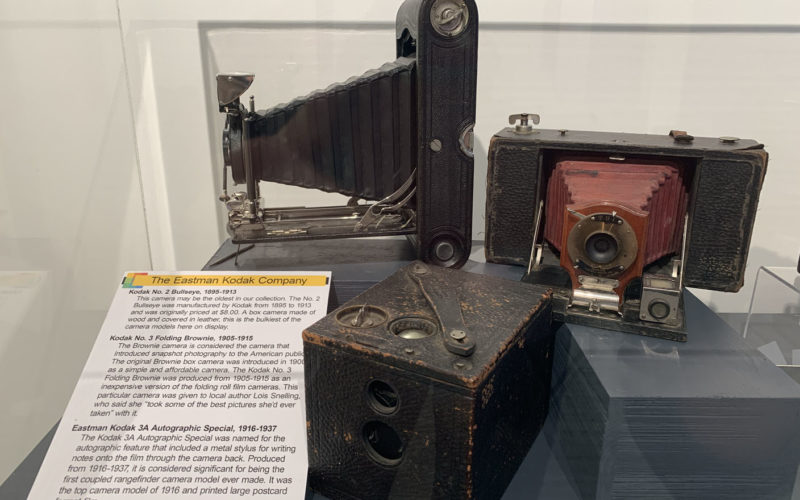BECCA MARTIN-BROWN
bmartin@nwaonline.com
“The desire to capture a moment in time has endured to the present. Ultimately, I think that photography has changed the way we look at the world.”
That’s Rachel Smith’s profound assessment of the lessons found in “From Portraits to Polaroids,” a new exhibit on show through July 8 at the Rogers Historical Museum.
“The theme ‘From Portraits to Polaroids’ was specifically inspired by an article I came across about how the ‘snapshot’ changed how we view the world,” says Smith, who is assistant director of the museum and curator of collections. “I found the idea fascinating that the evolution of photography mirrored an evolution in how we viewed the world.
“The exhibit describes how early forms of photography were difficult and expensive, remaining the territory of professional photographers well into the 1880s,” Smith says. “As photography became easier and more affordable, it changed the nature of photography. People started taking photographs of all kinds of things — people riding bicycles, children playing, and pets.
“The introduction of the first Kodak camera in 1888 marked a shift into the modern era of personal cameras and snapshot photography,” she adds. “Photographs were no longer limited to stiff formal portraits in the studio, but could capture candid moments and memories.”
Like all of the museum’s exhibits, this one was also inspired by its collections — which once again impressed Smith with their size, their scope and the history they revealed.
“I was surprised by the sheer number of professional photographers that operated in this area,” she says. “Even if they only stayed for a year or two, there are more than 40 professional photographers represented in the collections of the Rogers Historical Museum. They operated in Rogers, Bentonville, Gravette, Siloam Springs, Sulphur Springs and more, from the late 19th century on into the modern era.
“[And] after looking through our collection of cameras and photographic equipment, staff were also surprised at the number and variety of cameras we had,” Smith goes on. “Our collections manager, Jen Kick, conducted research on the various camera models and their features. We were then able to select a variety of cameras that represented the evolution of personal cameras, from the first Kodaks to modern Polaroids and more.”
Asked about the “coolest” artifacts in the exhibit, Smith has a ready answer. One of them, she says, is certainly a Graflex Speed Graphic camera with flash attachment.
“The Speed Graphic is considered the iconic press camera of the 1930s through the 1960s, used by award-winning photojournalists of the era,” she explains. “It was sturdy, relatively lightweight, and could capture action shots, making it ideal for newspaper photography. While this camera was not used by any newspaperman, it was owned by Gravette resident Guy Jones, who may have used it in his work for General Electric. The camera is one of the largest in the collection and is featured in its own case in the gallery.”
The exhibit also includes a number of cameras made by the Eastman Kodak Company, among them a No. 2 Bullseye box camera, likely the oldest in the museum’s collection, Smith says. Manufactured by Kodak from 1895 to 1913, it represents the first generation of Kodak personal cameras. Other interesting items include a Minox miniature “spy” camera from the 1970s, “photo booth” strips from the 1910s, and a camera with an attached stylus for writing notes on the film.
“The exhibit explores not only the world of professional photographers and early photographic processes, but also how everyday people embraced photography and used it to record their lives and photograph people and places around Benton County,” Smith concludes. “I hope that visitors can walk away with an understanding of the importance of photography and an appreciation for how it has changed over time.”
_
FAQ
‘From Portraits to Polaroids’
WHEN — Through July 8; hours are 10 a.m.-4 p.m. Tuesday-Saturday
WHERE — Rogers Historical Museum, corner of Second and Cherry in the Rogers Historic District
COST — Free
INFO — rogershistoricalmuseum.org or 621-1154



